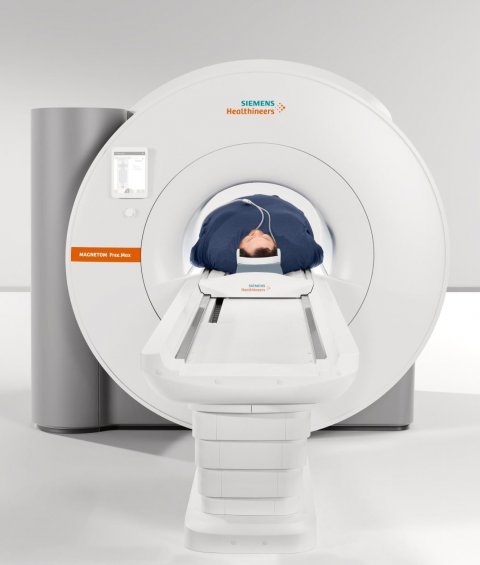News • Downsizing imaging
Siemens launches its smallest and most lightweight whole-body MRI
With its Magnetom Free.Max, Siemens Healthineers is presenting a new class of magnetic resonance imaging (MRI) systems that the company calls “High-V MRI.”
The scanner’s unique combination of digital technologies and the new field strength of 0.55 tesla broadens the range of clinical applications for MRI systems. Magnetom Free.Max considerably improves pulmonary imaging with MRI and allows patients with implants to be scanned much more accurately.

Siemens Healthineers has also enlarged the bore size to 80 cm, making the experience more comfortable for patients. The 80 cm opening is considerably larger than that of a conventional scanner and at the same time the biggest whole-body MRI bore available on the market. “Thanks to innovative digital solutions, such as the new Deep Resolve, Magnetom Free.Max can deliver image quality that used to be possible only at higher field strengths,” says Arthur Kaindl, Head of Magnetic Resonance Imaging at Siemens Healthineers. “Deep Resolve uses neural networks to generate high-resolution images from a lower input signal, which provides excellent diagnostic images and speeds up the scanning process.”
“In recent weeks, we already saw the full potential of the new scanner in clinical routine and, in addition to its wide application range, we were particularly excited about its capabilities for pulmonary imaging, which had not been a domain of MRI until now. With more than 70 lung patients examined so far, we have already been able to achieve very promising results. We also see great potential in terms of Covid-19 patients,” says Dr. Rafael Heiss of Erlangen University Hospital, where the first Magnetom Free.Max is located.
I believe MRI can significantly improve patient care directly at the frontline of diagnostics, in outpatient centers or even the emergency room
Elmar Merkle
Magnetom Free.Max can be installed in places where MRI used to be impossible. At just over three metric tons in weight and just below two meters in transportation height, the machine is the most lightweight as well as the most compact whole-body scanner Siemens Healthineers has ever built. The company developed a new magnet for this purpose with the so-called DryCool technology, which requires less than one liter of liquid helium for cooling and no quench pipe. Such machines used to require several hundred liters of helium and a costly quench pipe. To install the new scanner, rooms no longer have to be opened or converted at great cost. As a result, it can be easily installed for instance in locations previously not suitable for MRI. “I see great benefit in, for example, bringing MRI directly to the intensive care unit, as patient transport of critically ill patients to the central radiology department today is risky and cumbersome,” says Prof. Elmar Merkle, University Hospital Basel. “In addition, I believe MRI can significantly improve patient care directly at the frontline of diagnostics, in outpatient centers or even the emergency room, and could be implemented in spoke locations where today only CT or X-ray systems are available.”
With Magnetom Free.Max, Siemens Healthineers introduces myExam Companion to the field of MRI. myExam Companion is an artificial intelligence (AI)-based user guidance system which is already successfully used in modalities such as CT and X-ray imaging. It enables routine examinations to be automated, eliminating repetitive tasks and allows even novice technologists to operate the MR with ease. All users can obtain consistent and excellent image quality with each examination. Despite the high degree of automation, experienced users can fully configure the scanner at any time. As a result, they can meet even the most complex scanning requirements without problems. Magnetom Free.Max is also fully connected for continuous and remote monitoring. This shortens service intervals and helps to quickly transmit system diagnosis. Remote access by a service technician is often sufficient to detect and correct a defect, thus considerably improving system uptime further.
Source: Siemens Healthineers
18.11.2020











